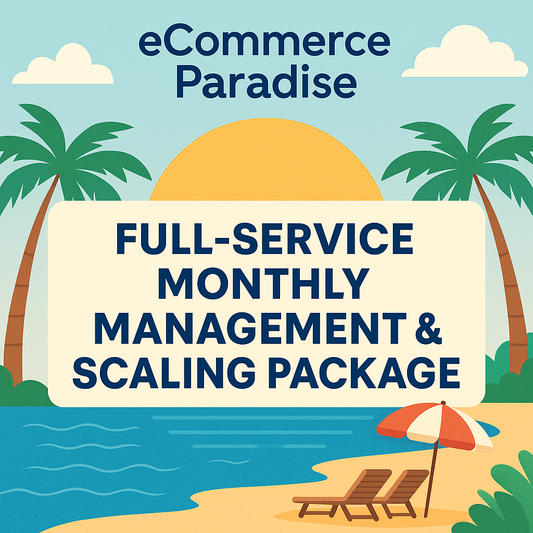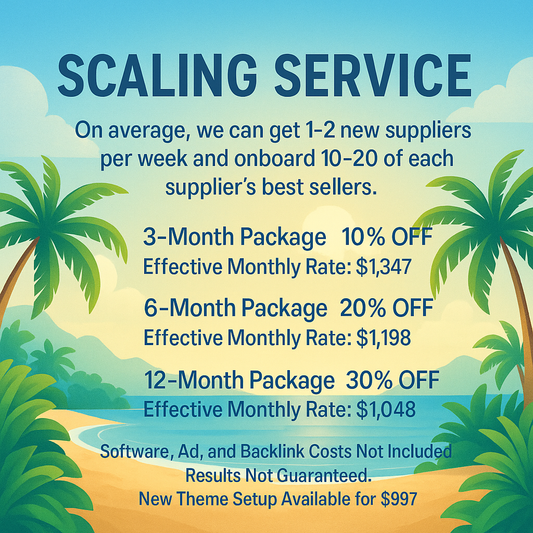
Mastering Ecommerce SEO: Your Guide to Success Metrics
Hey there, fellow ecommerce enthusiasts! Trevor Fenner here from Ecommerce Paradise, and today we're diving into the nitty-gritty of how to track and measure your ecommerce SEO success. Because let's face it, knowing where you stand is key to growing your online store. Whether you're dropshipping or running a fully stocked inventory, understanding your SEO metrics is crucial for making informed decisions and optimizing your strategy. So grab a cup of coffee, and let’s get started on the journey to ecommerce excellence!
Why Tracking Ecommerce SEO is Essential
Before we delve into the specifics, it's important to recognize why tracking your SEO is so vital. First off, ecommerce SEO isn’t just about driving traffic; it's about driving the *right* traffic. You want to attract customers who are genuinely interested in your products and, ultimately, convert visits into sales. Measuring your SEO success helps you to:
- Identify what's working and what's not.
- Optimize your strategies for better performance.
- Enhance user experience on your store.
- Improve your content strategy to align with customer needs.
Key Metrics to Track for Ecommerce SEO Success
When it comes to measuring ecommerce SEO success, several key metrics deserve your attention. Let's break them down to help you gain clarity and insights into your online store's performance.
Organic Traffic
Organcially sourced traffic is the lifeblood of your ecommerce platform. Use Google Analytics to monitor the volume of users coming from search engines. Look for trends over time to see if changes to your SEO strategy are having a positive effect. If your organic traffic is climbing, that's a great sign your SEO efforts are unfolding successfully.
Click-Through Rate (CTR)
Your click-through rate measures how many people click on your listings compared to how many times they show up in search results. A higher CTR indicates that your titles and meta descriptions are compelling enough to attract clicks. Focus on optimizing your product titles to make them more appealing. A/B testing can also provide insights into what works best.
Conversion Rate
At the end of the day, traffic means nothing if it doesn’t convert. Monitor your conversion rates from organic traffic. If you see a high volume of visitors but a low conversion rate, it may indicate problems with your product pages, pricing, or overall user experience. Take a hard look at aspects like your product descriptions, images, and navigation.
Leveraging Tools for Effective Tracking
To streamline the process of tracking your ecommerce SEO success, you can leverage various tools designed specifically for SEO analysis. Here are some must-haves:
Google Analytics
This free tool is invaluable for tracking user behavior on your site. With Google Analytics, you can see where your traffic is coming from, which pages people visit most, and how long they stay on your site. You can even set up goals to track conversions more accurately. It's a powerhouse for any ecommerce entrepreneur.
Google Search Console
Another essential tool, Google Search Console helps you monitor your website's presence in Google search results. It provides you valuable insights into which queries bring users to your site, and which pages are ranking well. If any of your key pages are struggling, you’ll be able to pinpoint issues and optimize accordingly.
SEO Audit Tools
There are many great SEO audit tools available beyond Google Search Console. Tools like SEMrush, Moz, and Ahrefs provide in-depth insights into your website's health and can help identify areas needing improvement. Here, you can track backlinks, keyword rankings, and much more.
Track Keywords Performance
Keyword performance tracking is critical for successful ecommerce SEO. If you're not in tune with how your target keywords are ranking, you could miss out on significant traffic. Use keyword tracking tools to keep an eye on your rankings. Look for shifts that may indicate the need for adjustments in your content or strategy.
Long-Tail Keywords
Don't just focus exclusively on high-traffic keywords; long-tail keywords often provide better conversion rates as they target users who are further along in their buying journey. For example, customers searching for "affordable sneakers for running" likely have different intent than someone searching just "sneakers." Including these long-tail keywords in your content can help you attract a more relevant audience.
The Role of Content in Ecommerce SEO
Your site content can't be an afterthought in your SEO strategy. Quality content works hand-in-hand with SEO to deliver value to your customers. It can significantly enhance engagement, trust, and branding. Here’s how to make your content count:
Product Descriptions
Optimize your product descriptions by incorporating relevant keywords naturally. Don't just write generic descriptions; focus on showcasing the benefits and unique features of your products. Ask yourself: what pain points does this product solve for my customers?
Blog Posts and Articles
Maintain an active blog on your site related to your niche, offering helpful resources, guides, and tips. Write about relevant topics that your target audience would find valuable. These blog posts can rank in search results, directing more traffic to your store and nurturing your authority as an expert in your field.
Email Marketing Integration
While this may not seem tied directly to SEO, it still plays a significant role in enhancing customer loyalty and engagement. Use your email marketing campaigns to promote your content, announce new product lines or sales, and encourage past customers to return. Many of these efforts lead to organic search and traffic growth!
Nailing Technical SEO
Technical SEO often gets overlooked, yet it’s fundamental for a solid ecommerce foundation. Here are key technical elements to be aware of:
Site Speed
Slow-loading sites create frustration for users and greatly increase your bounce rate. Google also takes site speed into account for your rankings. Use tools like Google PageSpeed Insights to analyze your speed and get suggestions for improvement. Aim for a loading time of under three seconds.
Mobile Optimization
With mobile commerce on the rise, ensure your site is fully optimized for mobile users. A mobile-friendly design enhances the experience for users on smartphones and tablets, crucial for retaining traffic and converting sales.
Secure Socket Layer (SSL)
Having SSL certificates is essential for securing your ecommerce transactions. Not only does it protect your customers, but Google also favors secure sites in rankings, so it’s a dual benefit!
Monitor Competitors
Keeping an eye on your competition can provide unique insights into your performance. Look at their SEO strategies, content, and keyword usage. What are they doing right? What can you learn from their mistakes? Various tools can help you analyze their strengths and weaknesses, ensuring you stay competitive.
Iterate and Improve
Measuring ecommerce SEO success is an ongoing process. The digital landscape is always changing, and so are customer preferences. Regularly revisit your SEO strategy, analyze your data, and be ready to tweak your approach as needed. A/B testing various strategies and continuously educating yourself on new SEO trends will keep you ahead of the game.
Your Pathway to Ecommerce Success
Your journey in the world of ecommerce SEO doesn't have to be overwhelming. Remember, tracking and measuring your SEO success leads to better decisions that can ultimately result in increased traffic and sales for your store. By focusing on critical metrics, leveraging the right tools, optimizing your content, and staying in tune with the competitive landscape, you're better equipped to navigate this exciting ecommerce landscape. So keep hustling, stay passionate, and let your ecommerce business thrive!


















